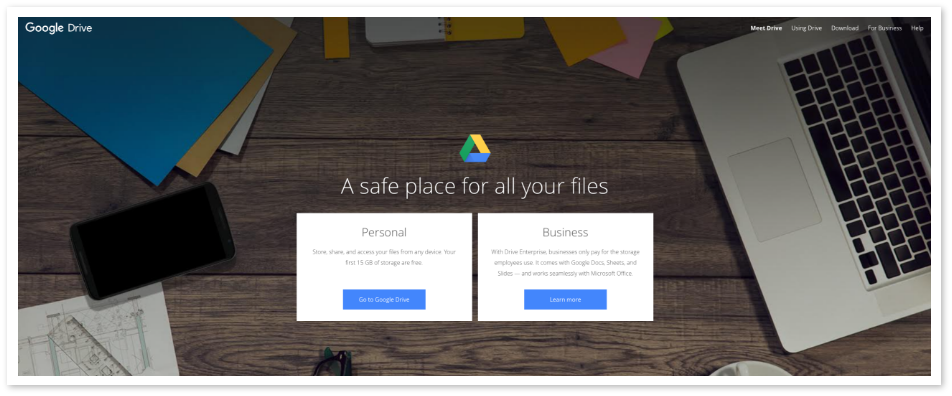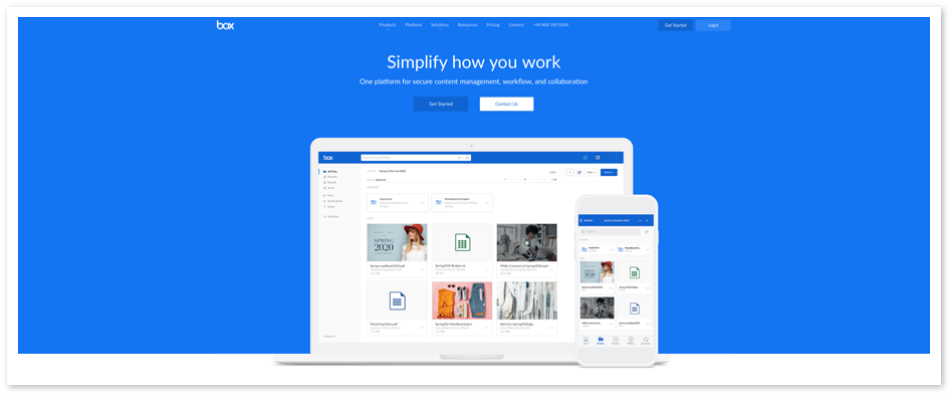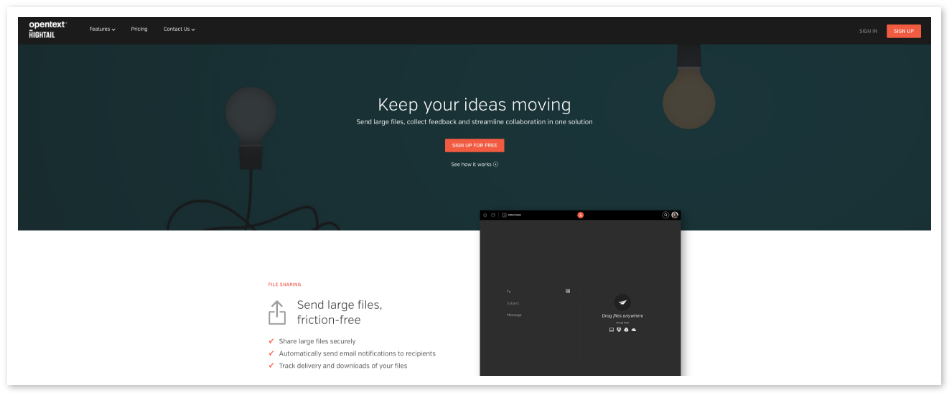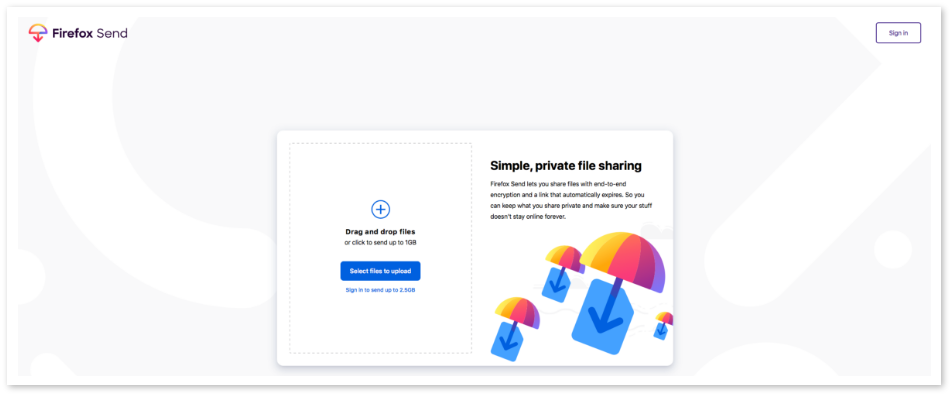How to share large files
When it comes to sharing large files with business contacts, it’s advisable to think twice before emailing them as attachments.
The same applies to sharing multiple medium-sized files that together amount to a large lot of data.
What’s the problem with emailing large files?
There are two main reasons not to email large files to business contacts.
The first lies in the fact that many mail servers have a limit on the collective size of a single email in terms of data used – which includes any and all attachments as well as the body of the email itself.
Some prescribe a further limit on the size of an individual attachment.
These limits vary widely from domain to domain, but on some mail servers it is still as little as 10 Mb. This means that you should never try to send emails whose total size including all attachments exceeds 10 Mb unless you know for a fact that the particular email serving domain you are sending to has a higher limit – and then you need to bear that higher limit in mind.
Even if you stay within the limit, you are effectively filling your recipient's email storage space and potentially blocking them from receiving further emails.
The second important reason not to send large emails is that many users who access email on mobile devices either have limits in terms of the monthly amount of bandwidth they are allowed to use on their paid plans or have data contracts on a pay-as-you-go basis, which means they have to pay for every megabyte of data downloaded over a particular limit. For these reasons, it is often unwelcome to send large emails unsolicited, as it could hugely inconvenience the recipients or cause them significant additional costs.
So what’s the solution?
Fortunately, nowadays there are plenty of viable alternatives to sending large files by email. Dedicated file-sharing platforms have sprung up, and these allow for files to be hosted in the cloud and then downloaded only by users who want to do so.
All you have to do is set up a link to the downloadable file and send that link to its intended recipient.
You no longer have to worry about email size limits with this procedure, and at the same time anyone with a limited mobile data contract can make arrangements to ensure that the download is carried out using another Internet connection facility so that no extra costs are incurred in respect of that contract.
In this article, we introduce and review the main features of ten file-sharing platforms that are used by businessses.
 1. Dropbox
1. Dropbox
Dropbox was founded as a company in June 2007 and first launched to the general public in September 2008 with the widely appealing offer of 2 Gb of free file storage on the cloud, which has been retained ever since.
On the back of this offer, its registered user base grew rapidly, reaching a million by April 2009, 100 million by November 2012 and 500 million by March 2016.
Using Dropbox on a Windows PC is easy. Once you have installed the program, an icon resembling five diamonds is permanently accessible from your desktop toolbar. This opens up a menu from which you select the icon labelled ‘Open Dropbox folder’. You can then copy and paste any files you want to share into this folder to start the process of uploading them to your cloud storage space. As soon as a file has finished uploading, you simply right click it in this folder and select ‘Copy Dropbox Link’. This copies a download-access link into your Windows clipboard. You can then paste it into an email and send the email to the individual(s) you want to download the file. Once a file has been successfully downloaded, you can delete it from your Dropbox folder by right-clicking it and selecting ‘Delete’, thereby freeing up space.
For power users who want to not only share small numbers of large files from time to time but also make use of a large cloud storage facility, paid Dropbox plans are available. The basic paid plan, called ‘Plus’, offers 2 terabytes of cloud storage and costs £7.99 per month.
 2. Google Drive / Google One
2. Google Drive / Google One
Google Drive was launched in April 2012 and had reached a user base of 800 million by March 2017.
Unlike Dropbox, it is not oriented towards users sending links to other users to download files so much as towards collaborative remote project-working.
Users can upload editable files such as documents and spreadsheets to their folder, then share access to these with selected other individuals. Flexible permission-setting allows the user to choose whether to allow others only viewing access or full joint editing access.
The free storage allowance on Google Drive exceeds that offered on Dropbox. At launch, it offered 5 Gb of free storage per account. This has since increased to 15 Gb.
As of 2019, paid plans have been rebranded Google One. These start at £1.59 for 100 Gb of storage, increasing to £7.99 / month for 2 Tb (equivalent to the entry-level paid plan on Dropbox).
 3. WeTransfer
3. WeTransfer
WeTransfer was launched in 2009 and is oriented primarily towards the sending of large files to other users. It differs from Dropbox in that there is no permanent storage facility offered on the free plan.
The maximum size of a single file or package of multiple files that can be sent with a free account is 2 Gb – the same as for Dropbox.
Using WeTransfer is extremely straightforward. There is no need to download a program.
You only have to go to the home page of the website at https://wetransfer .com and use the simple online interface to upload your files and specify the email address of their intended recipient. In fact, you can specify up to three recipients at a time, which can be useful when you are engaging in collaborative projects for business.
You can also add a personal message to help your recipient(s) recognise the eventual file transfer request as genuinely coming from you instead of possibly assuming it to be unsafe.
Once the transfer request is set in motion, the recipient will receive a courtesy email from WeTransfer inviting them to commence the download.
A time limit of seven days applies before the files are deleted from the cloud, so if the download is not commenced in that period of time, it will no longer be possible and you’ll have to start again.
Paid WeTransfer plans do allow cloud storage, though not as much as Dropbox. 500 Gb of storage is currently charged in Euros at €12 per month, packaged with a variety of other facilities.
 4. Box
4. Box
Box is one of the oldest file-sharing sites. The company was founded in 2005, but the program was originally developed the previous year as a university project.
Cloud storage is the central offering of Box. The free plan has a 10 Gb storage limit, five times as much as that offered by Dropbox, but there is a cap on the size of any single file at 250 Mb, which may be problematic for some large graphics and video files.
The basic paid plan costs £8 per month and allows 100 Gb of storage, with a 5Gb size limit to any single file. In the current marketplace, this offering is eclipsed by the entry-level paid plans offered by both Dropbox and WeTransfer.
 5. Hightail
5. Hightail
Opentext Hightail is similar to WeTransfer in that its main purpose is to share large files by faciliting their downloading from the cloud by a selected recipient.
As with WeTransfer, there is a 2Gb limit on the free plan, only in this case it applies to the combined total size of all files currently awaiting download by all recipients files have been offered to.
Like the equivalent on WeTransfer, Hightail’s free plan is not intended for long-term storage, and all files expire after seven days whether or not they have been downloaded.
Unlike WeTransfer, Hightail does not limit the number of recipients a single file can be sent to. However, Hightail’s free plan imposes a strict 100 Mb limit on the size of any single file, which means that it is not suitable for very large photographic PDFs.
There is also a paid-for Hightail plan called ‘Pro’, which boasts unlimited storage space and the option to keep files in the cloud for as long as you want without their expiring, making it more similar to Dropbox’s unlimited storage plan. This plan is very competitively priced at US $12 per month based on a minimum 12-month contract paid for as a single annual payment.
 6. MediaFire
6. MediaFire
MediaFire is a well-established file-sharing platform that was launched in June 2006. It had 43 million registered users by April 2016.
The free version of MediaFire offers 10 Gb of storage. The size limit for any individual file is 4 Gb. These features alone make it go further than the free versions of Dropbox and Box. Downloads are advertising-supported on the free service, and facilities are basic.
As on DropBox, files do not expire, and can be shared either privately to selected individuals by a non-transferable private one-time link, or to all and sundry via links sent in email newsletters or posted on your website.
The basic paid service, called MediaFire Pro, offers 1 Tb of file storage, which is less than the paid Dropbox service but is priced at a bargain $3.75 per month when paid in a single annual instalment, or at $5 if paid month-to-month – both of these prices are much cheaper than the 2 Tb services offered by Dropbox and Google One, making MediaFire Pro a highly competitive option for power users on a tight budget.
 7. Microsoft OneDrive
7. Microsoft OneDrive
Microsoft OneDrive was first launched to the public as Windows Live Folders in August 2007 before being renamed Windows Live SkyDrive only a week later. It was renamed OneDrive in February 2014 following a claim of trademark infringement by BSkyB.
OneDrive is focused on cloud storage and file-editing in the cloud. To begin with, 7 Gb of free storage was offered. For a limited time in 2012, existing users were allowed to upgrade their free storage allowance to 25 Gb, but once the time window had closed, this was no longer permitted. In June 2014, the standard storage allowance increased to 15 Gb, but in early 2016 it was cut to 5 Gb.
The entry-level paid service gives 100 Gb of free cloud storage and costs £1.99 per month.
For 1 Tb of storage, the equivalent offered by MediaFire’s basic paid service, the charge is £59.99 per year if paid annually, or £5.99 per month if paid monthly. This makes it almost twice the price of MediaFire’s equivalent plan (at September 2019 exchange rates).
 8. OneHub
8. OneHub
Onehub was founded in 2007 but is a relatively niche player in the cloud storage market compared with the biggest names, claiming just one million registered users as of September 2019. It is focused on collaborative online document sharing, and its pricing reflects its business-oriented market positioning.
Unlike its competitors, Onehub does not offer a free plan, but users are encouraged to sign-up for a free 14-day trial of its paid services.
The paid Onehub plans start at $29.95 per month for 1 Tb of cloud storage and a maximum of three users.
None of the Onehub plans is cheap when considered against the competition for equivalent storage allowances in the marketplace, but Onehub claims enterprise-grade security, a feature that may be attractive to large businesses and organisations handling sensitive data.
www.onehub.com/solutions/secure-file-sharing
 9. FireFox Send
9. FireFox Send
Firefox Send is one of the newest entrants to the file-sharing marketplace. It was launched to the public only in March 2019 after a 19-month trial period.
Like WeTransfer, Firefox Send is focused simply on the sending of large files through an easy-to-use website interface. Unregistered users are allowed to send files up to 1 Gb in size, but this cap is increased to 2.5 Gb for registered Mozilla Firefox account holders.
Firefox Send does not offer permanent cloud storage. All files uploaded to the service are time-limited. Download links created by registered Firefox users will also expire after seven days.
 10. GoFile
10. GoFile
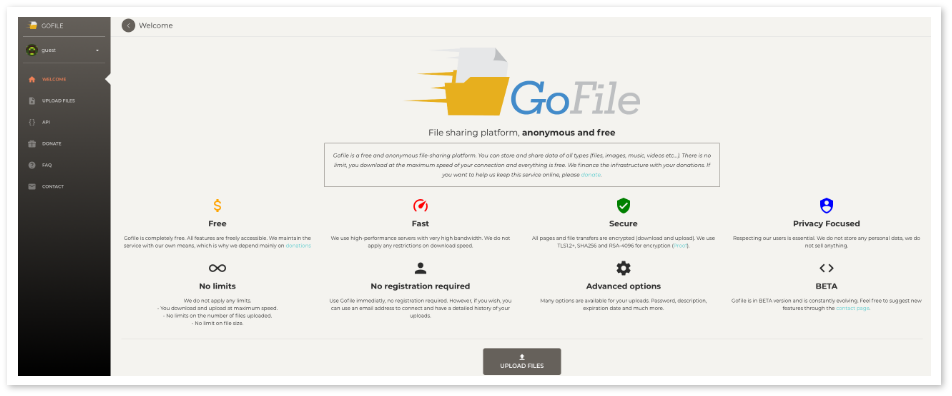
In the file sharing arena, GoFile can justly lay claim to being the wild kid in town. It is a free service that is supported entirely by donations.
What’s more, it offers total anonymity to those sharing files, a promise that is likely to appeal to a wide Internet user base afraid of their file-sharing activities being policed or tracked.
No user registration is required, and files can be uploaded direct from the home page.
A feature of GoFile that distinguishes it from WeTransfer and Firefox Send is that uploads are only deleted if they are inactive for seven days (or thirty days in the case of files larger than 100 Mb). This means that users whose files are being downloaded by multiple people at reasonably frequent intervals over a period of time can keep the files on the service without having to reupload them unless the time allowance between downloads is exceeded.
Donations using anonymous cryptocurrency platforms such as bitcoin and ethereum are encouraged to support the service, alongside Paypal donations.
Conclusion
Which file sharing service you choose in the first instance may depend more on what you are used to or what has been suggested to you by business contacts, but it often pays to consider other options, as there may be significantly more storage for your money with some providers, an easier-to-use interface with others, or a better provision of collaborative editing facilities, or more permanence of file storage, or even better security and privacy.
The best option for you may depend on your priorities out of all these considerations, but for small businesses needing more than the most basic facilities offered by the free plans, storage for the price is likely to be the one variable that carries the greatest weight in most cases, provided that file security is adequate.
If you enjoyed this article, you may find some of our other comparison and tips articles useful. Try ’10 Most Popular Content Management Systems Compared’, or ’16 Stock Photography Websites Reviewed’. Or if you have any queries, get in touch.


